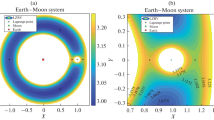Abstract
The problem of calculation of low-energy impulse trajectories to halo orbits in the vicinity of the L2 point of the Earth–Moon system is considered. A new method for calculating the trajectories of a single-impulse low-energy flight to a halo orbit is presented. The limited problem of four bodies is analyzed, within which the attraction of the Earth, Moon, and Sun is taken into account, and their position and speed are calculated using high-precision ephemeris support. Particular attention in the development of the method is paid to ensuring its computational stability for calculating trajectories with a long stay of a spacecraft (SC) in the zone of weak stability near the boundary of the Hill sphere of the Earth. The results of the calculation of single-impulse transfer trajectories from low Earth orbit to halo orbit around the L2 point of the Earth–Moon system are given. The analysis of the dependence of the main characteristics of single-impulse trajectories from the date of approach to the halo orbit is carried out.









Similar content being viewed by others
REFERENCES
Szebehely, V., Theory of Orbits: The Restricted Problem of Three Bodies, New York: Academic Press, 1967.
Markeev, A.P., Tochki libratsii v nebesnoi mekhanike i kosmodinamike (Libration Points in Celestial Mechanics and Cosmodynamics), Moscow: Nauka, 1978.
Folta, D.C., Pavlak, T.A., Haapala, A.F., et al., Earth–Moon libration point orbit stationkeeping: Theory, modeling, and operations, Acta Astronaut., 2014, vol. 94, no. 1, pp. 421–433. https://doi.org/10.1016/j.actaastro.2013.01.022
Shan, G., Wenyan, Z., Weiguang, L., et al., Trajectory analysis and design for relay satellite at Lagrange L 2 point of Earth–Moon system, J. Deep Space Exploration, 2017, vol. 4, no. 2, pp. 122–129. https://doi.org/10.15982/j.issn.2095-7777.2017.02.004
Folta, D.C., Pavlak, T.A., Haapala, A.F., et al., Earth–Moon libration point orbit stationkeeping: Theory, modeling, and operations, Acta Astronaut., 2014, vol. 94, no. 1, pp. 421–433. https://doi.org/10.1016/j.actaastro.2013.01.022
Gordon, D.P., Transfers to Earth–Moon L 2 halo orbits, Master Thesis of Science in Aeronautics and Astronautics, Purdue University West Lafayette, Indiana, 2008.
Wu, W., Tang, Y., Zhang, L., and Qiao, D., Design of communication relay mission for supporting lunar-farside soft landing, J. Sci. China Inf. Sci., 2018, vol. 61, no. 4, p. 14. https://doi.org/10.1007/s11432-017-9202-1
Davis, D., Bhatt, S., Howell, K., et al., Orbit maintenance and navigation of human spacecraft at cislunar near rectilinear halo orbits, 27th AAS/AIAA Space Flight Mechanics Meeting, Feb. 5–9, 2017, San Antonio, Texas, 2017, p. JSC-CN-38626.
Starchville, T.F. and Melton, R.G., Optimal low-thrust trajectories to earth-moon l2 halo orbits (circular problem), Adv. Astronaut. Sci., 1997, vol. 97, pp. 1741–1756.
Parrish, N.L., Parker, J.S., Hughes, S.P., et al., Low-thrust transfers from distant retrograde orbits to L 2 halo orbits in the Earth–Moon system, 6th Int. Conf. Astrodynamics Tools and Techniques, March 14–17, 2016, Darmstadt, 2016, p. GSFC-E-DAA-TN30224.
An, R., Wang, M., and Liang, X.G., Transfer trajectory optimal design for Earth–Moon L 2 based on invariant manifolds, J. Deep Space Explor., 2017, vol. 4, no. 3, pp. 252–257.
Ivanyukhin, A.V. and Petukhov, V.G., Low-energy sub-optimal low-thrust trajectories to libration points and halo-orbits, Cosmic Res., 2019, vol. 57, no. 5, pp. 378–388. https://doi.org/10.1134/S0010952519050022
Lei, H., Xu, B., and Sun, Y., Earth–Moon low energy trajectory optimization in the real system, Adv. Space Res., 2013, vol. 51, no. 5, pp. 917–929. https://doi.org/10.1016/j.asr.2012.10.011
Parker, J.S. and Born, G.H., Modeling a low-energy ballistic lunar transfer using dynamical systems theory, J. Spacecr. Rockets, 2008, vol. 45, no. 6, pp. 1269–1281. https://doi.org/10.2514/1.35262
Qi, Y. and Xu, S., Earth–Moon transfer with near-optimal lunar capture in the restricted four-body problem, Aerosp. Sci. Technol., 2016, vol. 55, pp. 282–291.
Richardson, D.L., Halo orbit formulation for the ISEE-3 mission, J. Guid. Control, 1980, vol. 3, no. 6, pp. 543–548.
Richardson, D.L., Analytic construction of periodic orbits about the collinear points, Celestial Mech., 1980, vol. 22, no. 3, pp. 241–253.
Petukhov, V.G. and Chzhou, Zh., Calculation of the perturbed impulsive trajectory of a transfer between near-Earth and near-lunar orbits using the parameter continuation method, Vestn. Mosk. Aviats. Inst., 2019, vol. 26, no. 2, pp. 155–165.
Kokou, P., Le Bihan, B., Receveur, J.B., et al., Computing an optimized trajectory between earth and an EML2 halo orbit, Proc. 2014 IEEE Chinese Guidance, Navigation and Control Conf. (CGNCC), Yantai, China, Aug. 8–10, 2014, p. 0450.
Belbruno, E. and Carrico, J., Calculation of weak stability boundary ballistic lunar transfer trajectories, Astrodynamics Specialist Conf., 2000, p. AIAA 2000-4142. https://doi.org/10.2514/6.2000-4142
Petukhov, V.G. and Ivanyukhin, A.V., Low-energy trajectories to the Earth–Moon libration points and to halo-orbits, IAA/AAS SciTech Forum 2019 on Space Flight Mechanics and Space Structures and Materials, Moscow, Vol. 174: Advances in the Astronautical Sciences Series, 2021, pp. 81–94.
Guzzetti, D., Zimovan, E.M., Howell, K.C., et al., Stationkeeping analysis for spacecraft in lunar near rectilinear halo orbits, 27th AAS/AIAA Space Flight Mechanics Meeting, American Astronautical Society, Feb. 5–9, 2017, San Antonio, TX, USA, 2017.
Zimovan, E.M., Howell, K.C., and Davis, D.C., Near rectilinear halo orbits and their application in cis-lunar space, 3rd IAA Conf. Dynamics and Control of Space Systems, Moscow, Russia, 2017, pp. 20–40.
Whitley, R.J., Davis, D.C., Burke, L.M., et al., Earth-Moon near rectilinear halo and butterfly orbits for lunar surface exploration, Proc. AAS/AIAA Astrodynamics Specialist Conf., Snowbird, UT, USA, Aug. 19–23, 2018.
Zimovan-Spreen, E.M., Howell, K.C., and Davis, D.C., Near rectilinear halo orbits and nearby higher-period dynamical structures: Orbital stability and resonance properties, Celestial Mech. Dyn. Astron., 2020, vol. 132, no. 5, p. 28. https://doi.org/10.1007/s10569-020-09968-2
Smith, M., Craig, D., Herrmann, N., et al., The Artemis program: An overview of NASA’s activities to return humans to the Moon, Proc. 2020 IEEE Aerospace Conf., Big Sky, MT, USA, March 7–14, 2020.
Author information
Authors and Affiliations
Corresponding author
Ethics declarations
The authors declare that they have no conflict of interest.
Rights and permissions
About this article
Cite this article
Zhou Rui A Method for Calculating the Trajectory of a Single-Impulse Flight to a Halo Orbit around the L2 Libration Point of the Earth–Moon System. Cosmic Res 61, 394–404 (2023). https://doi.org/10.1134/S0010952523700387
Received:
Revised:
Accepted:
Published:
Issue Date:
DOI: https://doi.org/10.1134/S0010952523700387




